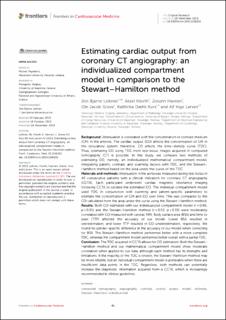| dc.contributor.author | Leiknes, Jon Bjarne | |
| dc.contributor.author | Hiorth, Aksel | |
| dc.contributor.author | Havnen, Jorunn | |
| dc.contributor.author | Greve, Ole Jacob | |
| dc.contributor.author | Kurz, Kathinka Dæhli | |
| dc.contributor.author | Larsen, Alf Inge | |
| dc.date.accessioned | 2024-02-19T13:07:57Z | |
| dc.date.available | 2024-02-19T13:07:57Z | |
| dc.date.created | 2023-12-20T09:28:11Z | |
| dc.date.issued | 2023 | |
| dc.identifier.citation | Leiknes, J.B., Hiorth, A., Havnen, J., Greve, O.J., Kurz, K.D. & Larsen, A.I. (2023) Estimating cardiac output from coronary CT angiography: an individualized compartment model in comparison to the Stewart–Hamilton method. Frontiers in Cardiovascular Medicine, 10 | en_US |
| dc.identifier.issn | 2297-055X | |
| dc.identifier.uri | https://hdl.handle.net/11250/3118470 | |
| dc.description.abstract | Background: Attenuation is correlated with the concentration of contrast medium (CM) in the arteries. The cardiac output (CO) affects the concentration of CM in the circulatory system; therefore, CO affects the time–density curve (TDC). Thus, estimating CO using TDC from test-bolus images acquired in computed tomography (CT) is possible. In this study, we compare two methods of estimating CO, namely, an individualized mathematical compartment model, integrating patient, contrast, and scanning factors with TDC, and the Stewart–Hamilton method based on the area under the curve of the TDC.
Materials and methods: Attenuation in the aorta was measured during test-bolus in 40 consecutive patients with a clinical indication for coronary CT angiography (CCTA). Each participant underwent cardiac magnetic resonance imaging following CCTA to validate the estimated CO. The individual compartment model used TDC in conjunction with scanning and patient-specific parameters to estimate the concentration of CM and CO over time. This was compared to the CO calculated from the area under the curve using the Stewart–Hamilton method.
Results: Both CO estimated with our individualized compartment model (r = 0.66, p < 0.01) and the Stewart–Hamilton method (r = 0.53, p < 0.01) were moderately correlated with CO measured with cardiac MRI. Body surface area (BSA) and time to peak (TTP) affected the accuracy of our model. Lower BSA resulted in overestimation, and lower TTP resulted in CO underestimation, respectively. We found no gender-specific difference in the accuracy of our model when correcting for BSA. The Stewart–Hamilton method performed better with a more complete TDC, whereas the compartment model performed better overall with a partial TDC.
Conclusion: The TDC acquired in CCTA allows for CO estimation. Both the Stewart–Hamilton method and our mathematical compartment model show moderate correlation when applied to our data, although each method has its strengths and limitations. If the majority of the TDC is known, the Stewart–Hamilton method may be more reliable, but an individual compartment model is preferable when there are insufficient data points in the TDC. Regardless, both methods can potentially increase the diagnostic information acquired from a CCTA, which is increasingly recommended in clinical guidelines. | en_US |
| dc.language.iso | eng | en_US |
| dc.publisher | Frontiers Media S.A | en_US |
| dc.rights | Navngivelse 4.0 Internasjonal | * |
| dc.rights.uri | http://creativecommons.org/licenses/by/4.0/deed.no | * |
| dc.subject | hjerte- og karsykdommer | en_US |
| dc.title | Estimating cardiac output from coronary CT angiography: an individualized compartment model in comparison to the Stewart–Hamilton method | en_US |
| dc.type | Peer reviewed | en_US |
| dc.type | Journal article | en_US |
| dc.description.version | publishedVersion | en_US |
| dc.rights.holder | © 2023 The Author(s). | en_US |
| dc.subject.nsi | VDP::Medisinske Fag: 700::Klinisk medisinske fag: 750::Kardiologi: 771 | en_US |
| dc.source.volume | 10 | en_US |
| dc.source.journal | Frontiers in Cardiovascular Medicine | en_US |
| dc.identifier.doi | 10.3389/fcvm.2023.1156332 | |
| dc.identifier.cristin | 2216029 | |
| cristin.ispublished | true | |
| cristin.fulltext | original | |
| cristin.qualitycode | 1 | |

